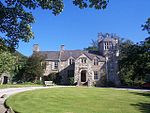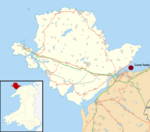Abergwyngregyn
AbergwyngregynPages with Welsh IPAUse British English from March 2015Villages in GwyneddVillages in Snowdonia

Abergwyngregyn (Welsh: [abɛrɡwɨnˈɡrɛɡɨn]) is a village and community of historical note in Gwynedd, a county and principal area in Wales. Under its historic name of Aber Garth Celyn it was the seat of Llywelyn ap Gruffudd. It lies in the historic county of Caernarfonshire. It is located at grid reference SH653726, adjacent to the A55, five miles (8 km) east of Bangor, eight miles (13 km) west of Conwy. The Aber community, which covers an area of 2,970 hectares (11.5 sq mi), has a population of 240 (2011).
Excerpt from the Wikipedia article Abergwyngregyn (License: CC BY-SA 3.0, Authors, Images).Abergwyngregyn
North Wales Expressway,
Geographical coordinates (GPS) Address Nearby Places Show on map
Geographical coordinates (GPS)
| Latitude | Longitude |
|---|---|
| N 53.234 ° | E -4.019 ° |
Address
North Wales Expressway
LL33 0LR , Aber
Wales, United Kingdom
Open on Google Maps







